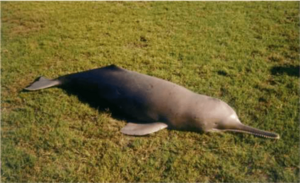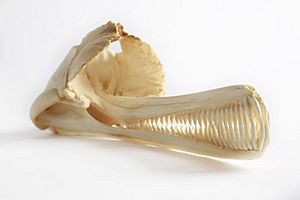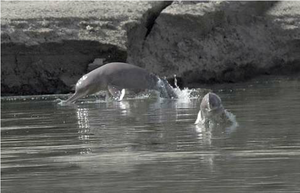Indus river dolphin facts for kids
Quick facts for kids Indus river dolphin |
|
|---|---|
 |
|
 |
|
| Size compared to an average human | |
| Conservation status | |
| Scientific classification | |
| Genus: |
Platanista
|
| Species: |
minor
|
 |
|
| Ranges of the Indus river dolphin and Ganges river dolphin | |
The Indus river dolphin (Platanista minor) is a special type of freshwater dolphin that lives only in the Indus River area of Pakistan and the Beas River in northwestern India. It is one of the few dolphins in the world that lives in rivers instead of the ocean. This dolphin is famous for being the first known dolphin to swim on its side.
Today, the dolphins live in five small, separate groups because large dams built for irrigation block their path along the river.
For a long time, scientists debated whether the Indus river dolphin and the Ganges River dolphin were different species. In 1998, they were grouped together as one species. However, recent studies of their genes and bodies suggest they are indeed two separate species. The Indus river dolphin is the national mammal of Pakistan and the state aquatic animal of Punjab, India.
Contents
How It Got Its Name

The Indus river dolphin was first identified in 1853 by a scientist named Richard Owen. He named it Platanista gangetica, var. minor because he had a skull that was smaller than the skulls of the Ganges river dolphin.
The scientific journey to classify this dolphin has been complex:
- At first, scientists thought the Indus and Ganges dolphins were the same species.
- In the 1970s, they were separated into two different species.
- In the 1990s, they were grouped back together as a single species with two subspecies.
- Today, most modern studies support the idea that they are two distinct species.
Scientists believe the Indus river dolphin and the Ganges river dolphin split into two separate species about 550,000 years ago during the Pleistocene era.
What It Looks Like
The Indus river dolphin has a very long, pointy snout, which is typical for river dolphins. Its teeth are visible in both its upper and lower jaws, even when its mouth is shut. In young dolphins, the teeth are long, thin, and curved. As they get older, their teeth change shape and become square and flat.
Seeing with Sound
A fascinating fact about this dolphin is that it is functionally blind. Its eyes are very small and don't have a lens, which is the part of the eye that focuses light. It can probably only sense the difference between light and dark.
So how does it find food and navigate? It uses a special skill called echolocation. The dolphin sends out high-pitched sounds that bounce off objects in the water, like fish or rocks. By listening to the returning echoes, it can create a "sound map" of its surroundings.
Body Shape and Size
The dolphin has a stocky, brownish body. Instead of a large dorsal fin like ocean dolphins, it has a small, triangular hump on its back. Its flippers and tail are quite large for its body size.
Males grow to be about 2 to 2.2 meters (6.6 to 7.2 feet) long, while females are larger, reaching 2.4 to 2.6 meters (7.9 to 8.5 feet). Females also have a longer snout, or rostrum, than males.
Where It Lives
The Indus river dolphin is now found only in the Indus River system. In the past, these dolphins lived in about 3,400 kilometers of the Indus River and its connected tributaries. Today, their home has shrunk by 80%, and they are found in only about 690 kilometers of the river.
They prefer to live in parts of the river that are deeper than 1 meter. The main population is in the Indus River in Pakistan, with a very small group also living in the Beas River in India.
Scientists are not sure how the dolphins originally got into both the Indus and Ganges river systems, since the rivers are not connected. One theory is that ancient rivers like the Sutlej and Yamuna changed their paths over thousands of years, carrying their dolphin populations with them.
Threats to Survival
The Indus river dolphin is an endangered species, and it faces many dangers caused by humans.
- Fishing Nets: Dolphins can get tangled in fishing nets and drown. This is a major cause of death for them.
- Water Pollution: Chemicals from farms and factories poison the river water, which harms the dolphins and the fish they eat.
- Dams and Barrages: The biggest threat is the construction of dams. These structures divide the river into sections, trapping the dolphins in small areas. This isolation prevents them from finding mates from other groups, which shrinks their gene pool and makes the population weaker.
- Hunting: In some areas, dolphins are still illegally hunted for their meat and oil, which is used in traditional medicine or as bait for fishing.
- Less Water: So much water is taken from the river for farming that the water levels drop, reducing the amount of space where the dolphins can live.
Conservation Efforts
The Indus river dolphin is protected by international laws. It is listed on Appendix I of CITES, which means it is illegal to trade these dolphins or any products made from them. It is also listed as Endangered by the IUCN Red List. It is considered the second most endangered dolphin or whale in the world.
Thankfully, conservation work is having a positive effect. The population is estimated to have increased from about 1,200 in 2001 to around 1,800 in 2017. This increase shows that protecting these animals can work.
To help them, scientists are studying the dolphins more closely. In 2022, they began using satellite tags to track the dolphins' movements. This information will help create better plans to protect their habitat and ensure their long-term survival.
See also
 In Spanish: Delfín del Indo para niños
In Spanish: Delfín del Indo para niños
- South Asian river dolphin
- Project Dolphin (India)
- Amazon river dolphin



